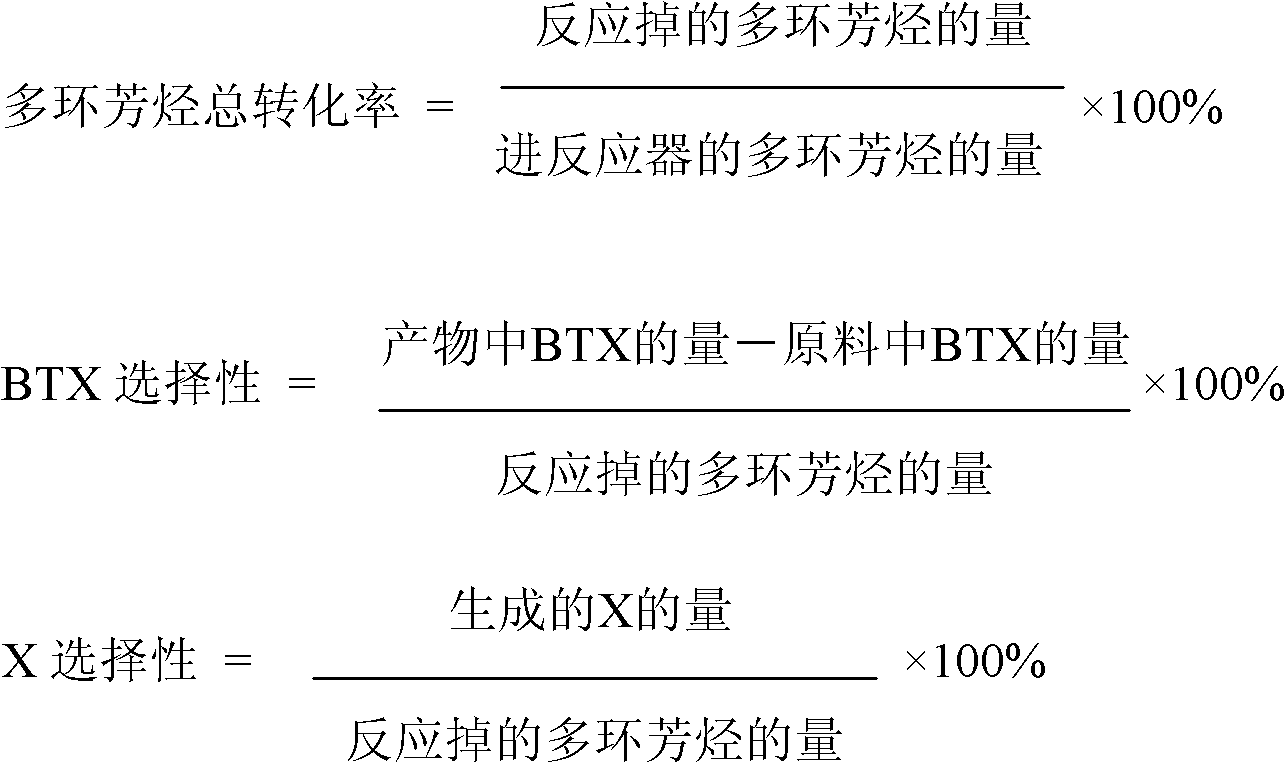Method for converting polycyclic aromatic hydrocarbons into monocyclic aromatic hydrocarbons to produce more dimethylbenzene
A technology for polycyclic aromatic hydrocarbons and monocyclic aromatic hydrocarbons, which is applied in the field of converting polycyclic aromatic hydrocarbons that produce more xylene into monocyclic aromatic hydrocarbons, can solve the problems of low conversion depth of polycyclic aromatic hydrocarbons, fast catalyst deactivation rate, low xylene yield, etc. problems, to achieve the effect of delaying the inactivation rate, improving the service life, and delaying the growth of aggregation
- Summary
- Abstract
- Description
- Claims
- Application Information
AI Technical Summary
Problems solved by technology
Method used
Image
Examples
Embodiment 1
[0028] Dry basis is 25g FAU type zeolite (commercially available hydrogen type), 25g MFI type zeolite (commercially available hydrogen type) and 50g γ-Al 2 o 3 (Industrial product) Add to the mixer until uniform, then add 3g of scallop powder, 5g of HNO at a volume ratio of 1:1 to the mixture 3 solution and 40g deionized water, and grind evenly to make a dough suitable for extrusion. It is extruded through a die, and the shape is a slender cylinder (diameter 1.7mm). After drying at 120°C, it is baked at 550°C for 4h, and then it is cut into carrier particles (1.7×4.0mm) with the same size, which is recorded as Z1.
[0029] Prepare a solution of chloroplatinic acid and zinc oxide to impregnate the carrier particles at 40°C. The amounts of Pt and Zn in the impregnation solution are 0.1% and 0.5% of the dry weight of the carrier, respectively. After 8 hours of immersion and drying, the Calcined at 450°C for 3 hours to obtain the finished catalyst A.
Embodiment 2~6
[0031] According to the preparation method and process provided in Example 1, a series of finished catalysts were prepared by changing the types of metal precursors in the impregnation solution during the impregnation of Z1 carrier particles, as shown in Table 1.
[0032] Table 1
[0033]
Embodiment 7~10
[0035] According to the preparation method and process provided in Example 1, a series of finished catalysts were prepared by changing the amount of metal impregnated during the impregnation of Z1 carrier particles, as shown in Table 2.
[0036] Table 2
[0037]
PUM
 Login to View More
Login to View More Abstract
Description
Claims
Application Information
 Login to View More
Login to View More - R&D
- Intellectual Property
- Life Sciences
- Materials
- Tech Scout
- Unparalleled Data Quality
- Higher Quality Content
- 60% Fewer Hallucinations
Browse by: Latest US Patents, China's latest patents, Technical Efficacy Thesaurus, Application Domain, Technology Topic, Popular Technical Reports.
© 2025 PatSnap. All rights reserved.Legal|Privacy policy|Modern Slavery Act Transparency Statement|Sitemap|About US| Contact US: help@patsnap.com



